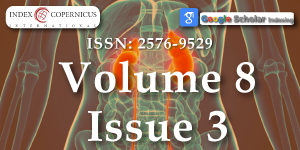Anatomo-clinical and Etiological Profile of Nephropathies Biopsied in the Nephrology Department of the Thies Regional Hospital (Senegal)
Main Article Content
Abstract
Introduction: In many developing countries, particularly in Africa, the use of renal biopsy (RB) in clinical nephrology is severely lacking. The objectives were to describe the anatomoclinical and etiological profile of these biopsied nephropathies, as well as the factors associated with the etiology of the nephropathies.
Patients and method: This was a retrospective descriptive and analytical study from 1 April 2020 to 30 October 2022. The patients were selected from the renal biopsy register of the nephrology department of the Thiès Regional Hospital. Sociodemographic, clinical, biological, and histological parameters were studied.
Results: 75 renal biopsies were included. The mean age was 33.3 ± 14.8 years, with a male predominance (65.3%). The main indications were nephrotic syndrome in 50.67% of cases. RB was adequate in 82.7%, inadequate in 13.3%, and borderline in 4%. Glomerular nephropathies predominated, with focal segmental glomerulosclerosis (FSGS) in 34.7%, membranous nephropathy (MN) in 17.3%, minimal change disease (MCD) in 10.67%, extracapillary glomerulonephritis (ECGN) in 5.3% and lupus nephritis (LN) in 3.9%. Thrombotic microangiopathy (TMA) was found in 9.3%. Chronic tubulointerstitial nephropathy (CTIN) accounted for 5.3% of all RB and acute tubular necrosis (ATN) for 4%. The etiologies were primary in 48%, secondary in 28%, and undetermined in 24%. In the bivariate analysis, the etiology was correlated with the mean SBP (p = 0.023), the mean level of hemoglobin (p = 0.028), the levels of GFR (p = 0.017), and the type of kidney disease (p = 0.000).
Conclusion: Glomerular nephropathy was more frequent and FSGS was the most common histological lesion found. Primary causes predominated. Associated factors were identified to improve patient management.
Article Details
Copyright (c) 2024 Dieng A, et al.

This work is licensed under a Creative Commons Attribution 4.0 International License.
Maisonneuve P, Agodoa L, Gellert R, Stewart JH, Buccianti G, Lowenfels AB, et al. Distribution of primary renal diseases leading to end-stage renal failure in the United States, Europe, and Australia/New Zealand: results from an international comparative study. Am J Kidney Dis. 2000;35(1):157-65. Available from: https://doi.org/10.1016/s0272-6386(00)70316-7
Iversen P, Brun C. Aspiration biopsy of the kidney. Am J Med. 1951;11(3):324-330. Available from: https://doi.org/10.1016/0002-9343(51)90169-6
Okpechi IG, Swanepoel CR, Duffield M, Mahala B, Wearne N, Alagbe S, et al. Patterns of renal disease in Cape Town, South Africa. Nephrol Dial Transplant. 2011;26(6):1853-1861. Available from: https://doi.org/10.1093/ndt/gfq655
Lemrabott AT, Dial MC, Faye M, Cissé MM, Samb A, Seck SM, et al. Senegalese renal biopsy registry: descriptive analysis of 492 nephropathies biopsied from 2009 to 2012. Nephrology & Therapeutics. 2016;12(5):269. Available from: https://doi.org/10.1016/j.nephro.2016.07.339
Zerdoumi F, Medjamia M, Boudani S. Epidemiological profile of nephropathy. Therapeutic Nephrology. 2021;17(5):318-329. Available from: https://doi.org/10.1016/j.nephro.2021.07.185
Mbarki H, Belghiti KA, Harmouch T, Najdi A, Arrayhani M, Sqalli T. Kidney biopsy puncture in the Nephrology Department of Fez: indications and results: about 522 cases. Pan Afr Med J. 2016;24:21. Available from: https://doi.org/10.11604%2Fpamj.2016.24.21.3982
Mhamedi SA, Meghraoui H, Benabdelhak M, Bentata Y, Haddiya I. Renal biopsy: indications, complications and results. Pan Afr Med J. 2018;31:44. Available from: https://doi.org/10.11604/pamj.2018.31.44.15604
Kallossy Ousmane. Renal biopsy: indications, results and complications in the nephrology and hemodialysis department of the Luxembourg mother-child hospital [exercise thesis]. Mali: University of Sciences, Techniques and Technologies of Bamako; 2021.
Diouf B, Ka EF, Niang A, Mbengue M, Ka MM, Diouf ML, et al. Analysis of 115 kidney biopsies performed in Dakar (Senegal). Dakar Med. 2001;46(1):51-53. Available from: https://pubmed.ncbi.nlm.nih.gov/15773158/
Lemrabott AT, Faye M, Cissé MM, Fall K, Seck SM, Kane Y, et al. Senegalese kidney biopsy registry: descriptive analysis of 1559 nephropathies biopsied over a period of 7 years. Therapeutic Nephrology. 2019;15(5):273-283. Available from: https://doi.org/10.1016/j.nephro.2019.07.029
Keita Y, Dial CMM, Sylla A, Lemrabott AT, Faye M, Cissé MM, et al. Pathological profile of primary segmental and focal hyalinosis (HSF) in children in Dakar: about 61 cases. Therapeutic Nephrology. 2016;12(5):341-350. Available from: https://doi.org/10.1016/j.nephro.2016.07.157
Eljouehari M, Flayou K, Raoundi O, Benamar L, Rhou H, Bayahia R, et al. Pathological and evolutionary profile of primary idiopathic segmental and focal hyalinosis. Therapeutic Nephrology. 2015;11(5):379-388. Available from: https://doi.org/10.1016/j.nephro.2015.07.352
Nyirahabineza A. Idiopathic segmental and focal hyalinosis: About 104 cases [Exercise thesis]. Morocco: Mohammed V University of Rabat; 2016.
D’Agati VD, Alster JM, Jennette JC, Thomas DB, Pullman J, Savino DA, et al. Association of histologic variants in FSGS clinical trial with presenting features and outcomes. Clin J Am Soc Nephrol. 2013;8(3):399-406. Available from: https://doi.org/10.2215/cjn.06100612
Traore H, Maiza H, Emal V, Dueymes JM. Renal biopsy: indications, complications and results in 243 renal biopsies. Nephrology & Therapeutics. 2015;11(5):339-348. Available from: https://doi.org/10.1016/j.nephro.2015.07.249
Covic A, Schiller A, Volovat C, Gluhovschi G, Gusbeth-Tatomir P, Petrica L, et al. Epidemiology of renal disease in Romania: a 10 year review of two regional renal biopsy databases. Nephrol Dial Transplant. 2006;21(2):419-424. Available from: https://doi.org/10.1093/ndt/gfi207

